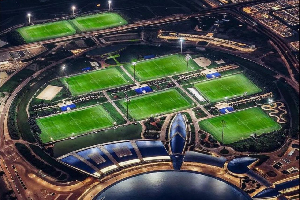Qatar promised the world something “never seen before” and with the 2025 FIFA U-17 World Cup, they have delivered a football experiment so ambitious it almost feels unreal.
A 48-team World Cup squeezed into a single city, played on pitches barely ten metres apart, powered by some of the most advanced sporting technology on the planet.
No country has ever attempted this. Qatar is not just attempting it, they are thriving.
The tournament, which kicked off on November 3, 2025 and will climax on Thursday, November 27, 2025, with Portugal facing Austria in the final, has turned Doha’s Aspire Zone into football’s most extraordinary laboratory.
Behind the spectacle lies a question that has fascinated players, coaches, fans, and officials alike: How on earth can an entire World Cup, 104 matches, be staged inside one sports complex?
Abedi Pele appointed to Inter-Ministerial Advisory Board on Sports
A city of technology disguised as a stadium district
The Aspire Zone is not a stadium precinct; it’s a hyper-engineered sports ecosystem.
Every inch is wired for efficiency. Qatar has used its wealth of high-performance technology, from climate-controlled pitches to automated turf-management systems, to compress what is normally a continent-wide operation into a single district of Doha.
Forget flights. Forget buses. Forget long transfers. Here, teams walk from their hotel to training.
From training to the pitch. From the pitch to recovery labs. Everything is within reach, engineered for zero wasted energy.
The pitches themselves are the heart of the miracle: world-standard FIFA-approved surfaces, each individually climate-regulated, sitting so close together you could jog from one to the next in under a minute. Their proximity is absurd. Their design is ingenious.
Pitches named after legends, built for the future
Ahead of the tournament, Qatar honoured its football icons by naming each field, from Mohammed Ghanim to Mansour Muftah.
But the real story lies beneath the grass: cooling pipes, humidity regulators, sensor-driven sprinklers, and real-time pitch analytics capable of adjusting turf firmness based on player load.
This is a turf that thinks. This is playing surface as smart technology.
And there are nine of such pitches working simultaneously, a feat unmatched anywhere in world football.
104 matches, 25 days, one zone
In any other country, staging 104 games would require multiple cities, hundreds of buses, thousands of kilometres of travel, and countless logistical headaches. Qatar has stripped all of that away.
In Aspire Zone, referees, teams, broadcasters and officials rotate through matches like shifts in a factory, except the factory is a world-class sports metropolis, complete with hotels, hospitals, restaurants, performance centres, recovery pods, and the iconic Khalifa International Stadium, which will host the final.
The entire World Cup, every minute, every goal, every storyline, has unfolded inside one zone, with the final act moving a short walk away into one of Qatar’s most historic venues.
When clips went viral showing that the pitches are barely ten metres apart, fans were left in awe.
A finale born in a laboratory
On Thursday, November 27, 2025, when Portugal meet Austria inside the Khalifa International Stadium, it won’t just be a final.
It will be the climax of a technological triumph World Cup played inside one city, powered by engineering, efficiency, and innovation.
FKA/JE
Meanwhile, watch as Global Data Protection expert Patricia Adusei-Poku outlines key projects she is leading:



